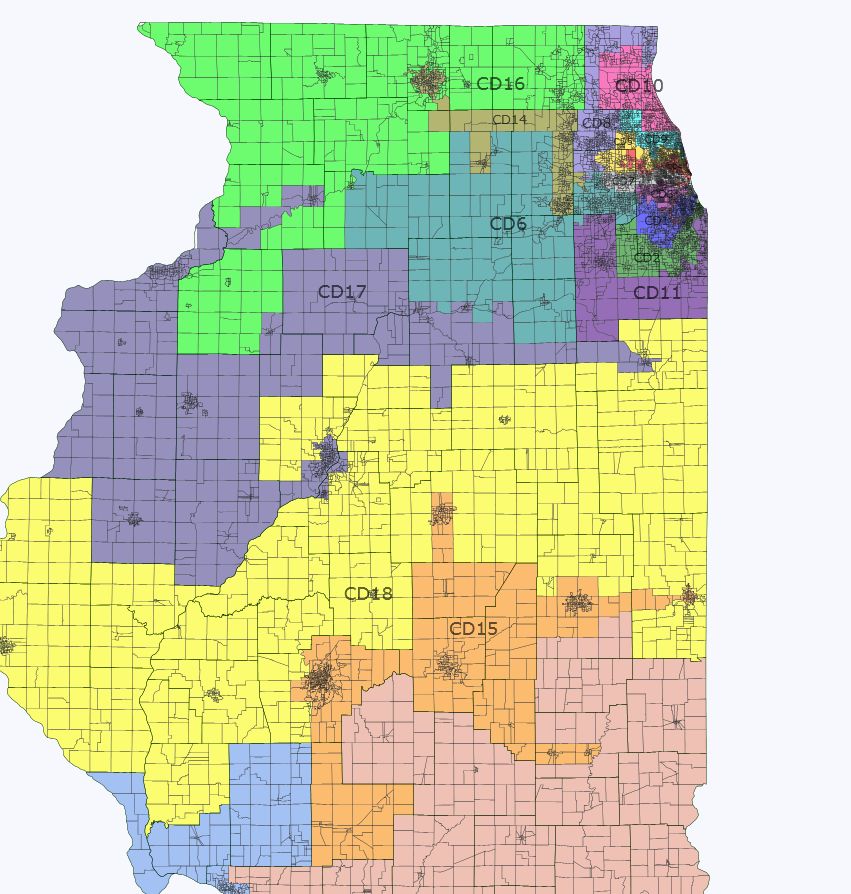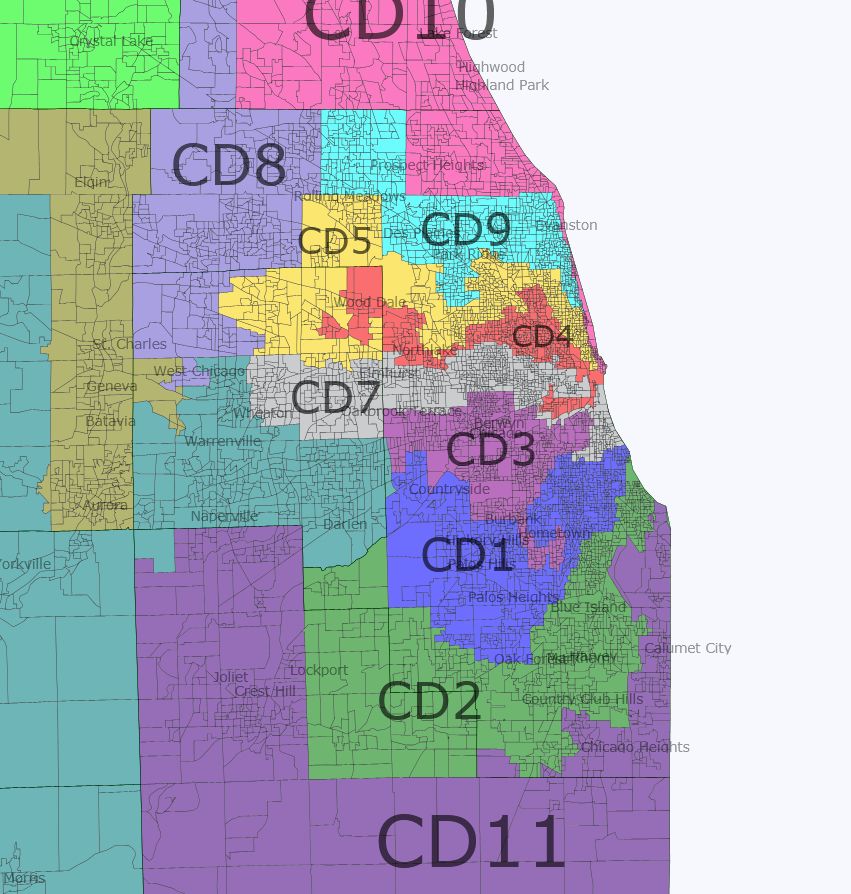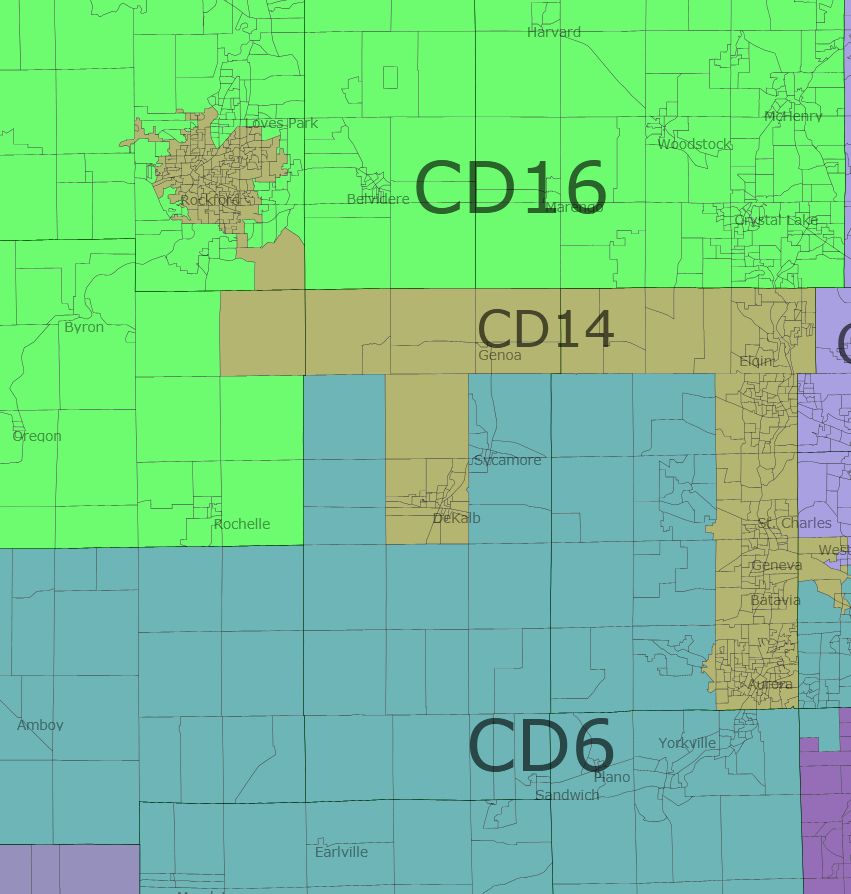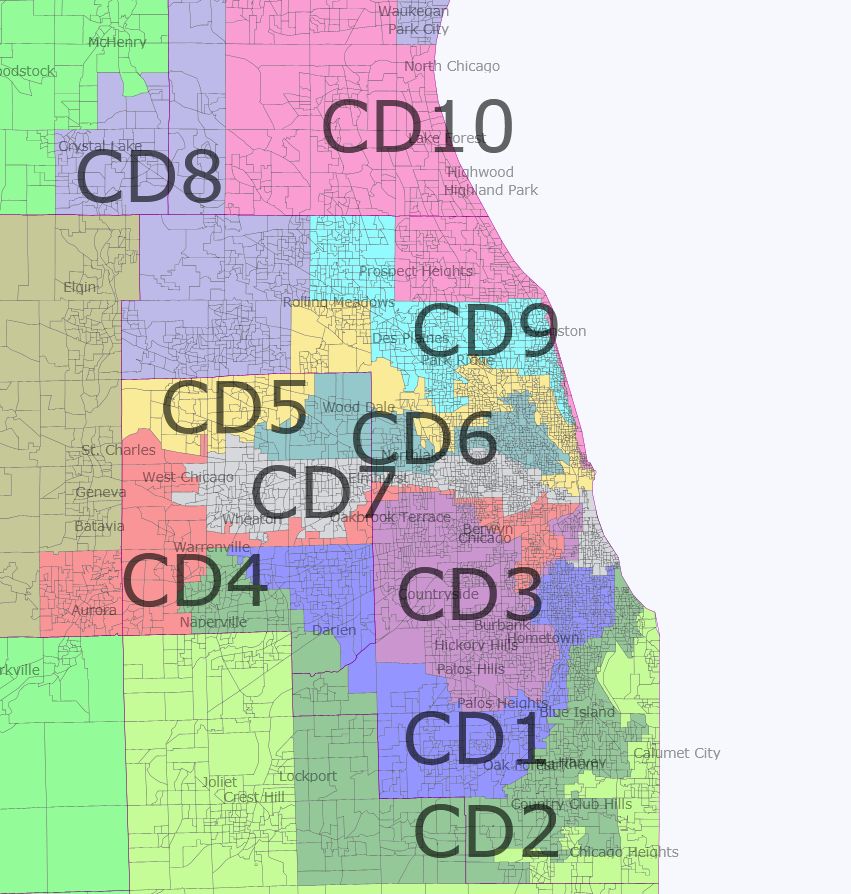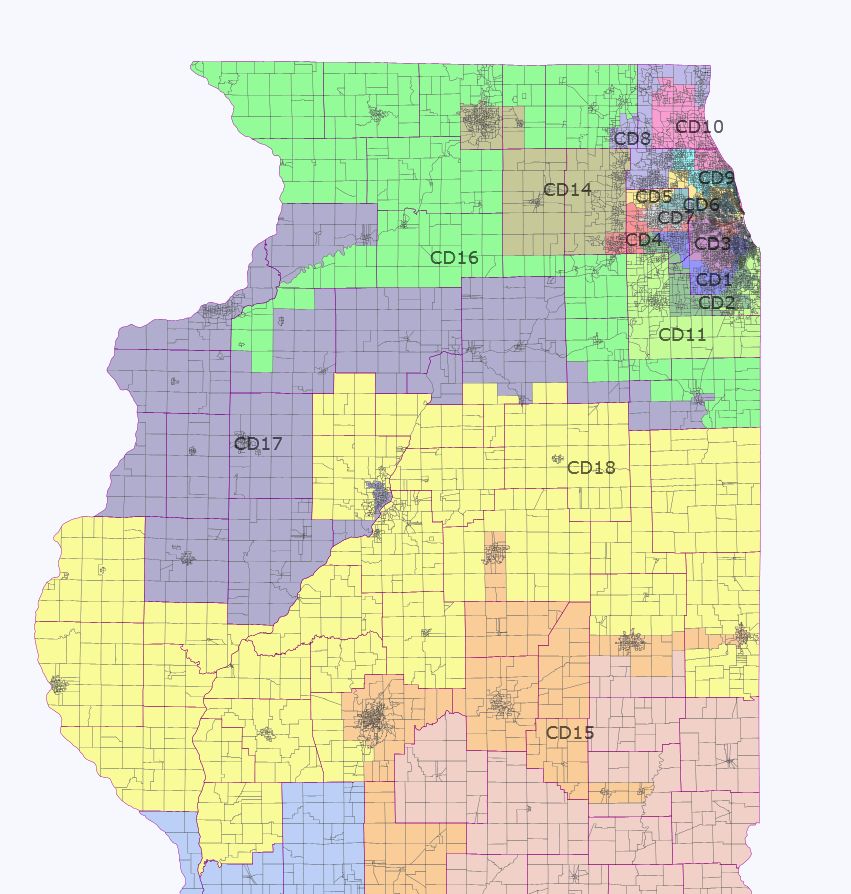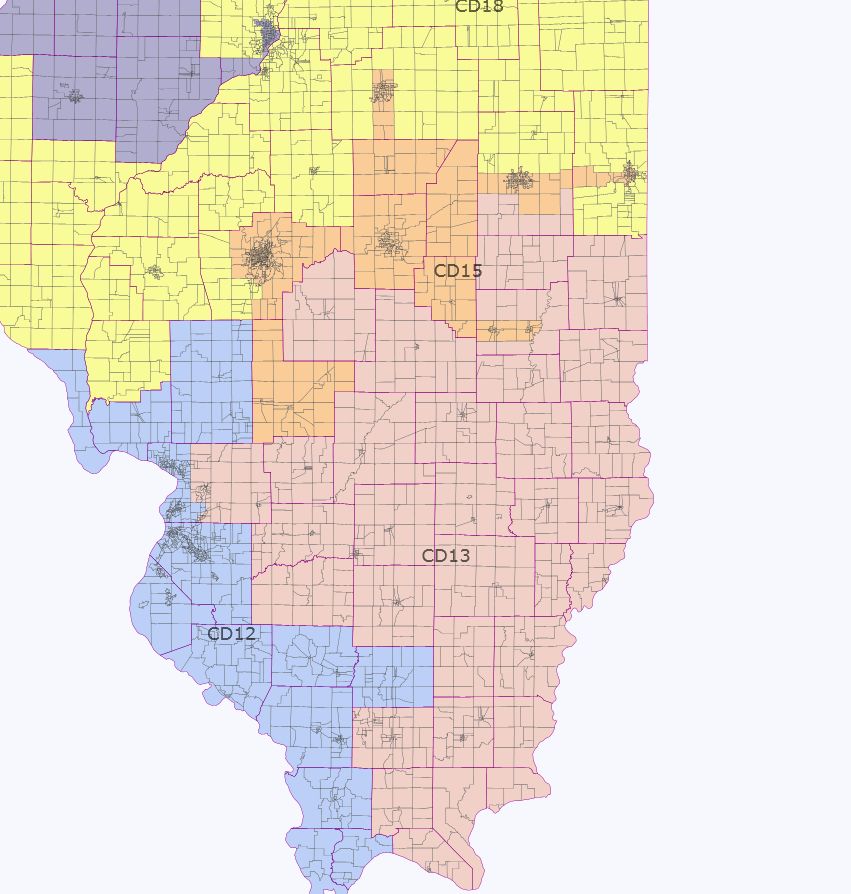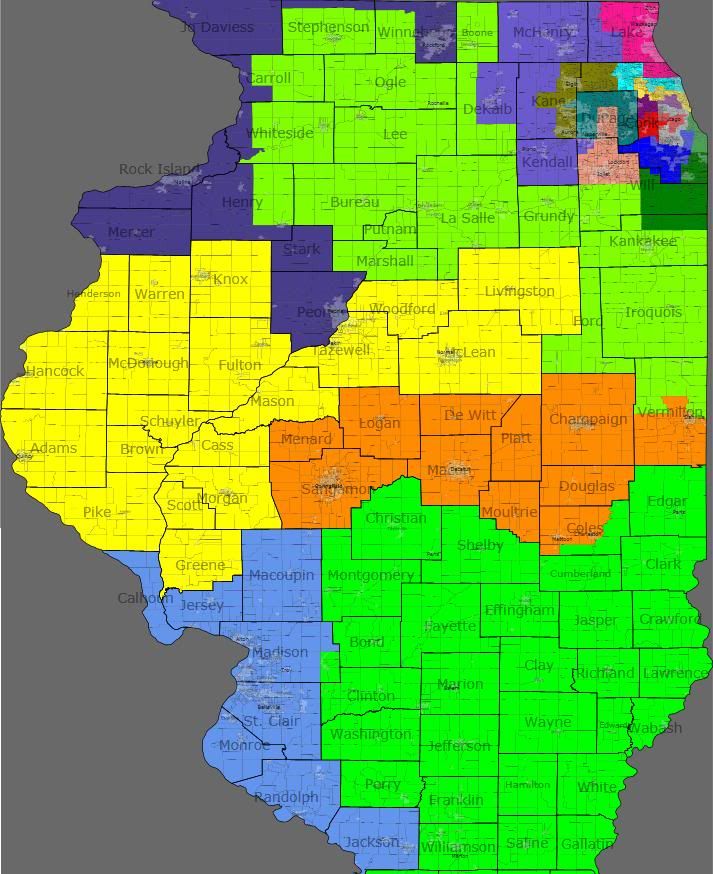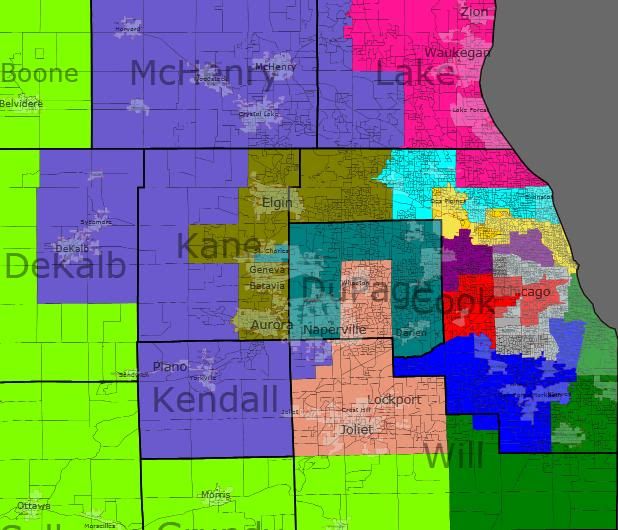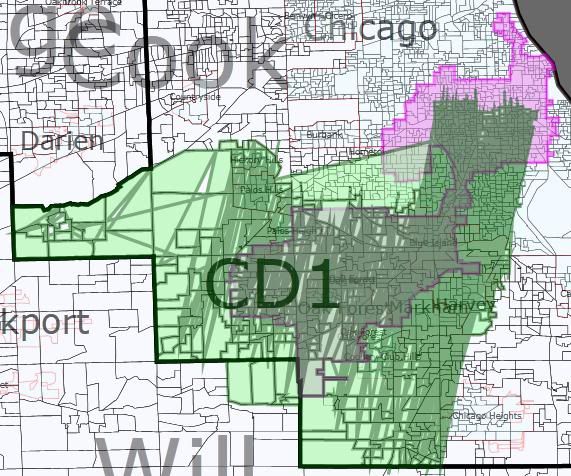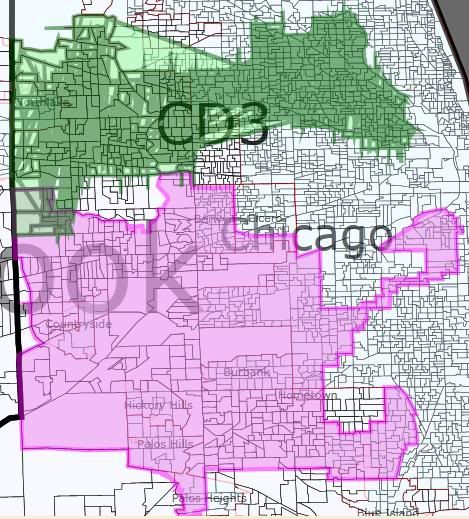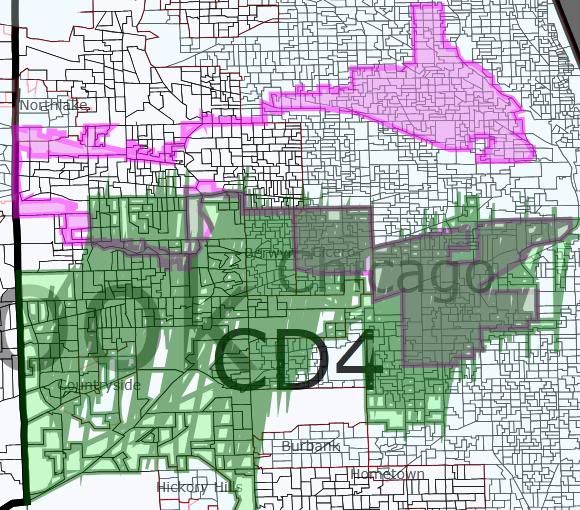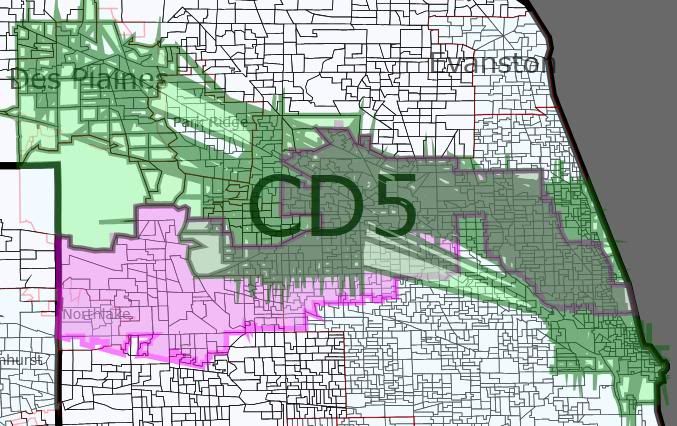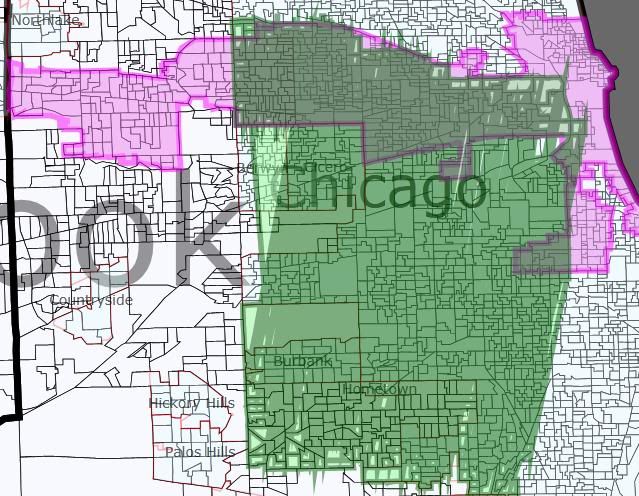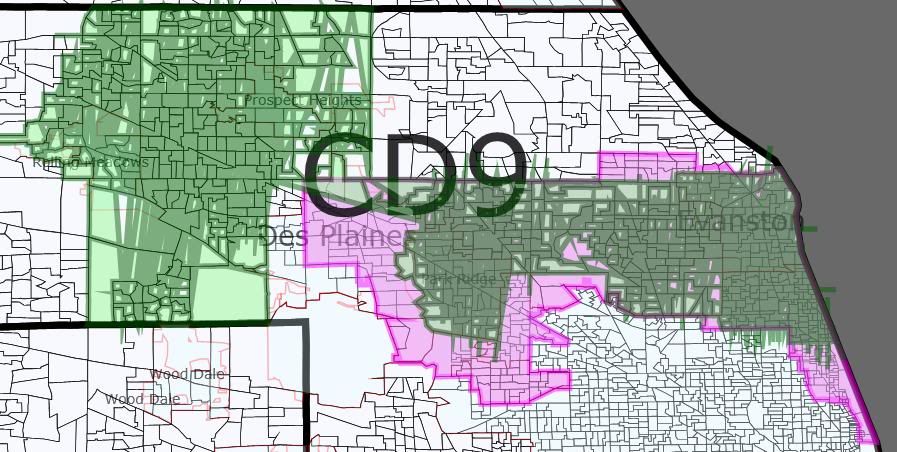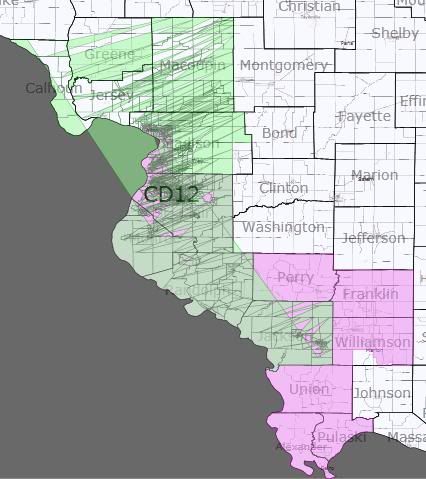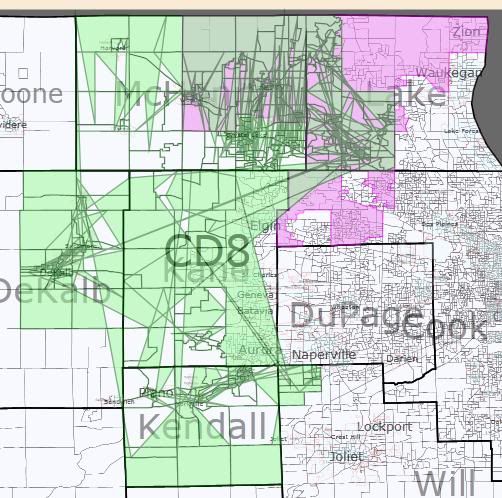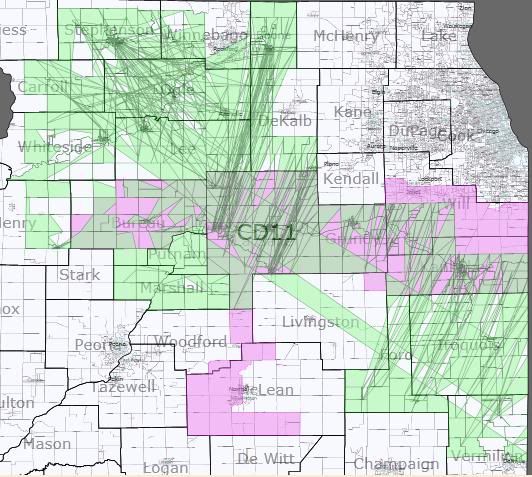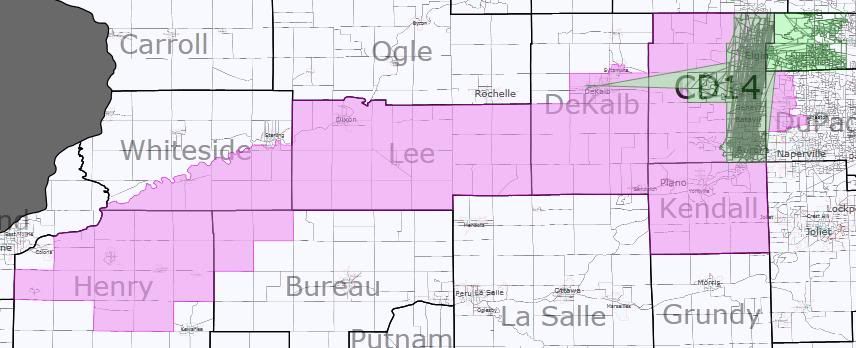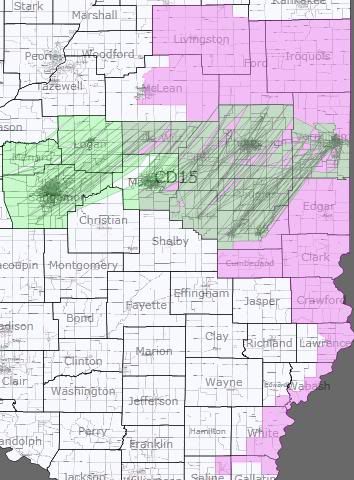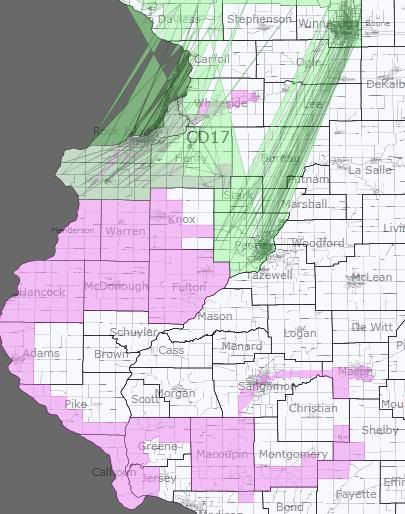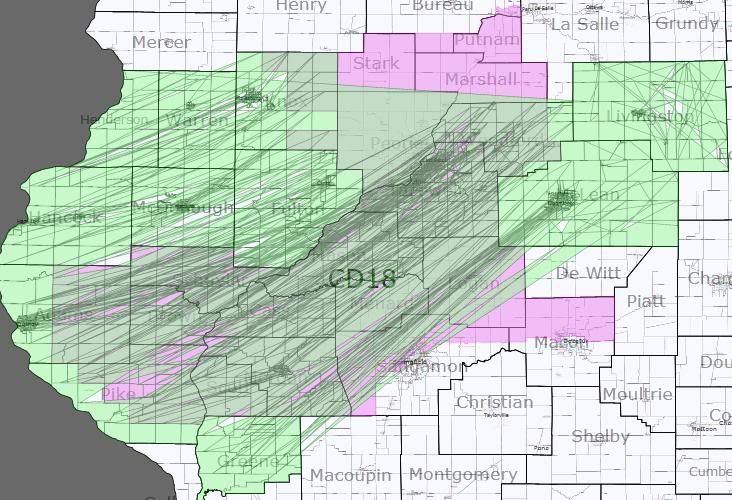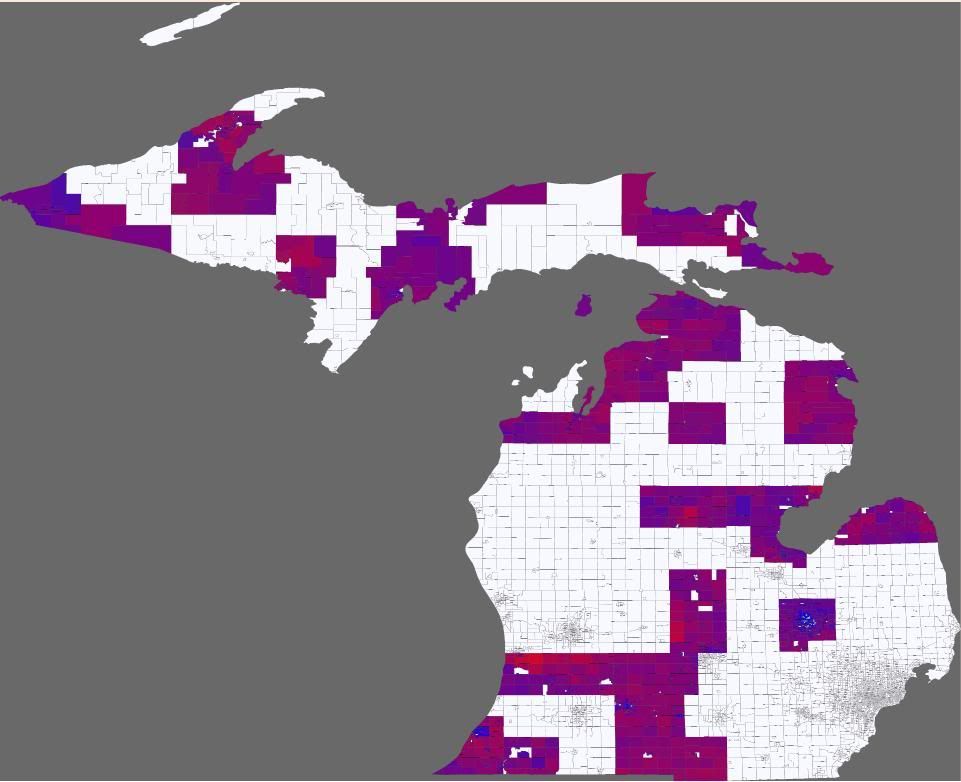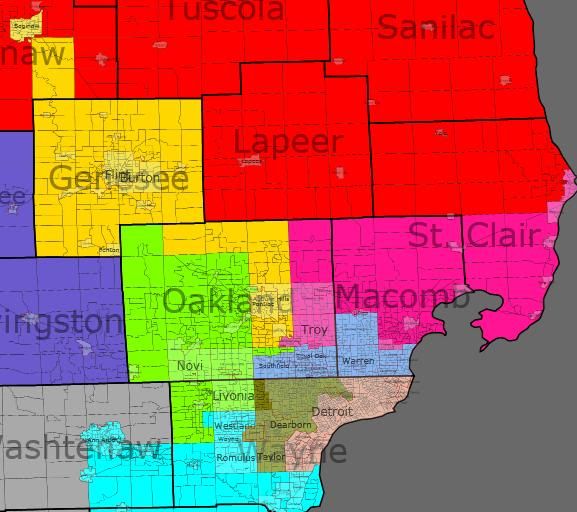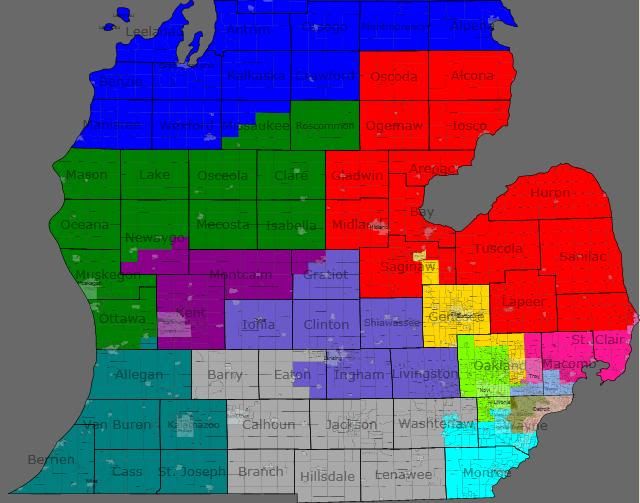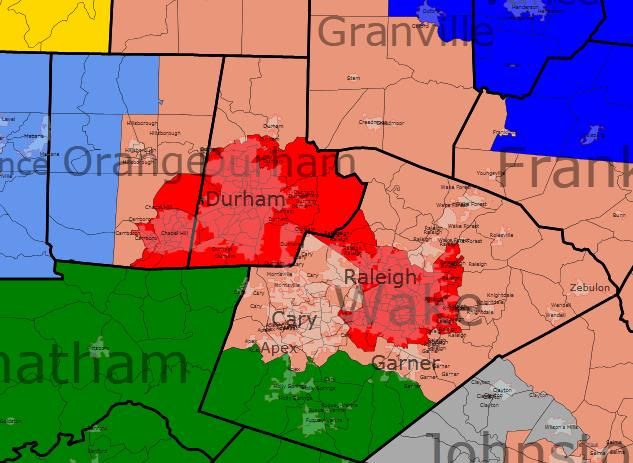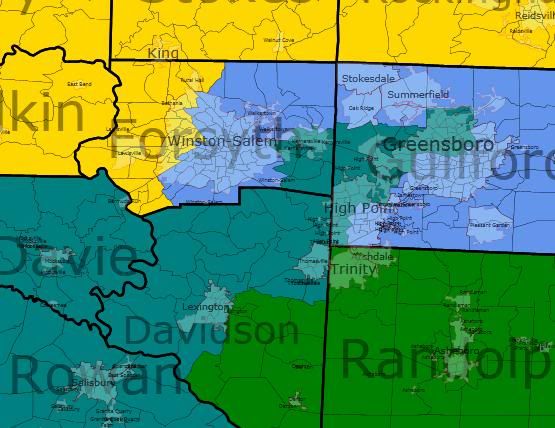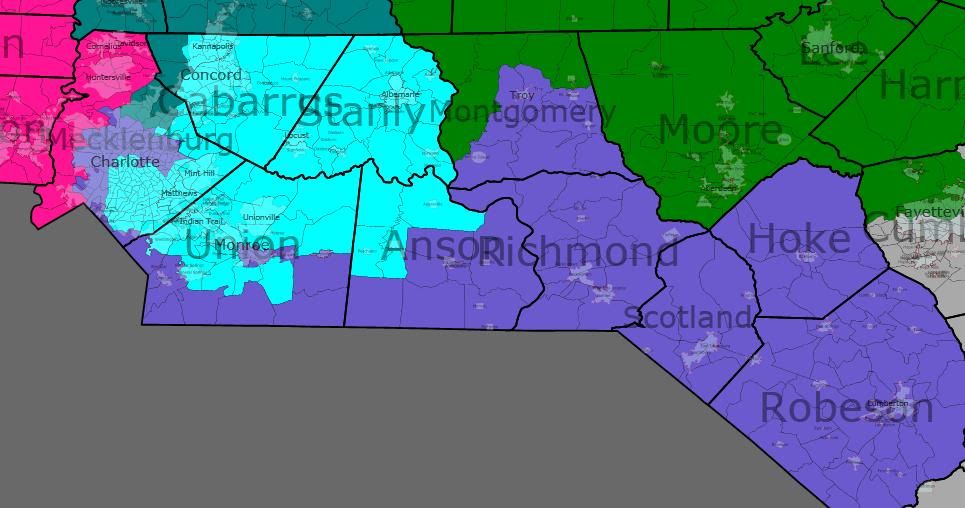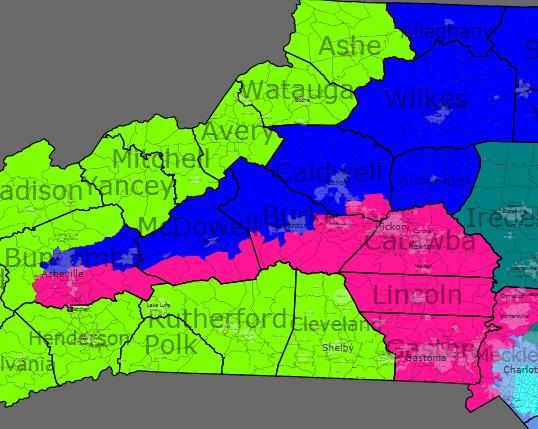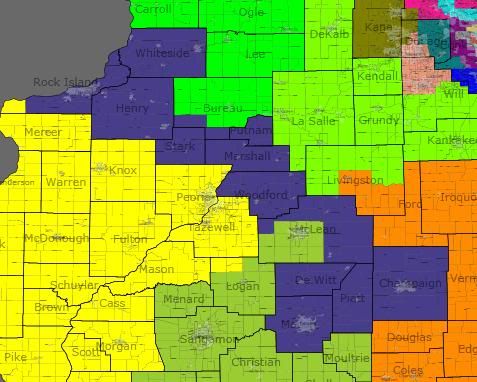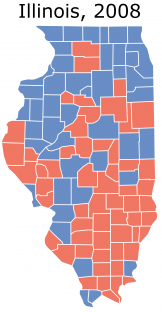Illinois looks to be one of the few bright spots for Democrats in redistricting. An unexpected hold of the Governor’s seat gives Illinois Democrats the vaunted trifecta. This map assumes blank things:
1) There will be 3 black VRA districts and a single Hispanic district. In the next redistricting there will likely finally be 2 Hispanic seats. For now the Hispanic community is too spread out to effectively draw a district.
2) Comebacks aren’t the most effective way to go. Some of those had no right to be blue (see IL-14, IL-8), drawing a map based on those districts isn’t the wisest path for a Democratic gerrymander.
3) The Democrats won’t shy away from drawing districts that require a fight. There’s an impulse toward the safest path in the Democratic party. A map with about 10 surefire Democratic seats may be possible, but this year it’s worth it to push for the extra seats.
It’s been done to death, but it’s where I live and work so, without further ado:




CD 1 (Blue)- Bobby Rush (D)
W: 39% B: 54%
Major Cities: Orland Park, Tinley Park, Orland Park, Blue Island, Homer Glen, Chicago
Safe Democratic
Bobby Rush’s southwest side district remains mostly the same. It is significantly less black than it was before, but it is still a majority. The district reaches out and grabs a significant chunk of the current 13th district. It will remain a safe Democratic district, if not so overwhelmingly.

CD 2(Dark Green)-Jesse Jackson Jr. (D)
W: 32% B: 54% H: 11%
Major Cities: Chicago Heights, Calumet City, Peotone, Chicago
Safe Democratic
Similar to the 1st district the 2nd grabs some Republican leaning areas and becomes significantly less black. Like the 1st it’s still a solid Democratic district and Rep. Jackson’s as long as he wants it.

CD 3 (Purple)-Dan Lipinski (D) or Judy Biggert (R)
W: 64% H: 27%
Major Cities: Hinsdale, Burbank, Oak Lawn, Berwyn, Cicero, Chicago
Safe Democratic
Judy Biggert’s home is technically in the 3rd, but running here would be an uphill fight for her. More likely she’ll decide that at 75 her decades of public service are enough. The core of the Lipinski family’s 3rd district is still there. It picks up more Hispanic areas in the east to offset the areas of DuPage it grabs.

CD 4(Red)-Luis Gutierrez (D)
W: 19% H: 70%
Major Cities: Chicago
Safe Democratic
It’s still super-Hispanic. The northern enclave is somewhat larger and the southern one somewhat smaller. The connection between the sections is less painfully gerrymandered.

CD 5(Yellow)-Mike Quigley (D)
W: 64% H: 23%
Major Cities: Addison, Bensenville, Elmwood Park, Chiago
Lean Democratic
The 5th district grabs a large chunk of downtown Chicago and a large chunk of DuPage County. I’m most worried about this district’s safety, back of the envelope numbers and a couple of guesses say the district should be safe, but actual results would make me feel better about the seat. Quigley does hold onto most of his base and the majority of the district is in Chicago. Admittedly I’m being over cautious.

CD 6(Teal)-Peter Roskam (R), Randy Hultgren (R), or Judy Biggert (R)
W: 75% A: 9% H: 10%
Major Cities: Wheaton, Naperville, Downers Grove, St. Charles, Barrington Hills
Safe Republican
Bench: Fred Crespo-HD 44
The 6th district becomes a suburban Republican vote sink. Roskam’s district keeps its Wheaton base, grabs Republican strongholds in Naperville, St. Charles, and Barrington Hills. All of the west and northwest suburban precincts that are unpleasant for Democrats get stuffed in here. If Democrats insist on running a candidate who is more than a placeholder, state rep Fred Crespo held his seat in November and could run. It’s a bad idea, but if the party insists. On the Republican side both Roskam and Hultgren live in the district. Both represented the 48th district in the state Senate and a primary fight between the two would be something to see. A big part of Biggert’s base is in the district. She could decide to run here, but is as likely to retire. Which is disappointing because I’d pay to see a three-way brawl between sitting Republican Congressmen.

CD 7(Silver)-Danny Davis (D)
W: 25% B: 53% H: 16%
Major Cities: Villa Park, Elmhurst, Bellwood, Oak Park, Chicago
Safe Democratic
Davis’ district picks up some new territory in DuPage. It’s still a majority black district (though less than before). And it’s still a Democratic district, though less than its current D+35.

CD 8(Purple)-Joe Walsh (R) or Vacant
W: 67% H: 19%
Major Cities: Waukegan, Lake Forest, Highland Park, Vernon Hills, Grayslake, Gurnee
Lean Democrat
Bench-Rep. Melissa Bean, Sen. Susan Garrett LD-29, Sen. Terry Link-LD 30
The 8th pulls almost entirely out of Cook County and takes the whole of Lake County plus a sliver of Barrington. It’s a swing district. Bean may have been able to hold it this year, especially against Walsh. This district leans ever so slightly Democrat. Bean could run again here, she’s not a retread for most of the district. She kept the score close throughout Lake County in 2010, and won it in 2008. Even Dan Seals won the parts of Lake in the 10th in 2010 and 2008. If Bean doesn’t make an attempt to reclaim her seat State Senators Susan Garrett and Terry Link are positioned to make a run for Congress.

CD 9(Blue)-Jan Schakowsky (D)
W: 64% A: 11% H: 14%
Major Cities: Evanson, Park Ridge, Des Plaines, Evanston, Chicago
Safe Democrat
Schakowsky’s seat doesn’t change much. She loses much of Skokie and Niles and picks up more of Chicago and Republicans areas around Northfield, Wheeling and Rosemont. If anything her seat comes out stronger.

CD 10(Pink)-Bob Dold (R)
W: 70% A: 14% H: 12%
Major Cities: Schaumberg, Rolling Meadows, Arlington Heights, Skokie, Northbrook
Lean Democrat
Bench: Rep. Elaine Nekritz HD-59, Sen. Jeff Schoenberg LD-9, Julie Hamos, Dan Seals
This seat should have been a Democratic seat ages ago. Any gerrymander should be sure to put the 10th over the top. The 10th now stays mostly within Cook County, ducking into DuPage for just a few thousand votes. If Democratic strongholds in Schaumburg, Niles, Skokie, Northbrook and Winnetka combined with Democratic trending Hoffman, Elk Grove and Palatine can’t produce a Democrat in this district then there truly is a curse. Popular state Senator Jeff Schoenberg could make a successful run for the seat, though the real boon would be state rep Elaine Nekritz. Nekritz is an archetypical suburban Democrat: socially progressive and fiscally moderate. She would run the table in a district like this. Some area Democrats are hoping for a Julie Hamos comeback. I dislike the idea personally because of the first rule of suburban Chicago politics: if you can’t beat Dan Seals you don’t get a second chance. Which leads us to Dan Seals, who could take a fourth crack at the seat. By no means should he, but by no means should he have run this year, so we’ll have to see.

CD 11(Blue)-Adam Kinzinger (R) or Tim Johnson (R)
W: 79% B: 11%
Major Cities: Champaign-Urbana, Bloomington-Normal, Decatur, Danville, Kankakee
Tossup
Bench: Sen. Mike Frerichs-LD 52
The 11th grabs every Democratic leaning city in eastern Illinois. The college towns Champaign-Urbana (People’s Republic of) and Bloomington-Normal as well as the union towns of Decatur and Danville make up half to two-thirds of the district. The rest of the district is decidedly anti-Democrat. Putting this district in the D-column comes down to a turnout fight. Sen. Mike Frerichs is a Democrat who can win right-leaning voters. He’ll be able to stop a Republican from running up the score in between the cities. Tim Johnson lives in Urbana and represents the 15th district currently. He could run here and have a chance to win, but up-and-comer Adam Kinzinger also live in the district. Johnson has seniority, but Kinzinger has the potential to be a rising star of the party. Here’s hoping for a cage match.

CD 12(Blue)-Jerry Costello (D)
W: 79% B: 16%
Major Cities: East St. Louis, Edwardsville, Carbondale, Alton, Cairo
Safe Democrat
The 12th is relatively unchanged. It picks up some new territory in Calhoun County and around Edwardsville, drops some of Williamson and Jefferson Counties, and remains a safe district for incumbent Costello.

CD 13(Pink)-Randy Hultgren (R) or Vacant
W: 61% B: 11% H: 24%
Major Cities: Joliet, Aurora, Lockport, Romeoville, Batavia
Lean Democratic
Bench: Rep. Bill Foster, Rep. Linda Chapa LaVia-HD 83, Sen. Linda Holmes-LD 42, Sen. Arthur Wilhelmi-LD 43.
The 13th district picks up Aurora and Joliet for its loses in DuPage. This district is distinctly more Democratic. It’s not a district to take for granted, but in a fair fight expect a Democratic win. Bill Foster could run for this district from Batavia, or any member of the deep bench in the area could rally a coalition of minority and working class voters in the area. Sen. Wilhelmi would, I believe be the strongest candidate on the Democratic side. Hultgren could run here if the party moved to protect Roskam. It would ultimately be a fools errand; in 2010 Foster pounded Hultgren 61-37 in Aurora.

CD 14(Brown)-Joe Walsh (R) or Vacant
W: 71% H: 19%
Major Cities: Elgin, Rockford, McHenry, Crystal Lake, Batavia
Tossup
Bench: Rep. Jack Franks-HD 63, Rep. Keith Farnham-HD 43, Sen. Mike Noland-LD 22
Joe Walsh could run here. He’s claiming his home is in McHenry now. McHenry County was good to Walsh in 2010 and he may want to stay with his base. The district is not as Republican as it looks at first glance. Democratic Rockford and Elgin make up about half of the district while McHenry county not is the wasteland it was five or ten years ago. Democrat Jack Franks has kept his northwest McHenry county seat Democratic for more than a decade now. If Franks runs it’s a narrow advantage for the Democrats, if he doesn’t it’s a complete tossup.

CD 15(Orange)-Tim Johnson (R) or John Shimkus (R)
W: 93%
Major Cities: Charleston, Effingham, Colinsville, Metropolis, Centralia
Safe Republican
Bench: Rep. Jay Hoffman-HD 112, Rep. Brandon Phelps-HD 118, Sen. Gary Forby-LD 59
The Republicans have to go somewhere. This is one of them. Any democrat running here is a ConservaDem placeholder. The interesting thing to watch could be two powerful Republicans wailing on each other. If Johnson is pushed out of the 11th to make way for Kinzinger then it’s likely that he’ll hop the border and try to run in the 15th. About a third of Johnson’s old 15th remains in the new 15th. If neither Johnson nor Shimkus feel like retiring things could get fun down here, grab the popcorn.

CD 16(Light Green)-Don Manzullo (R)
W: 87%
Major Cities: Freeport, Galena, Rochelle, DeKalb, Morris, Lasalle
Lean Republican
Bench: Rep. Careen Gordon-HD 75, Rep. Frank Mautino-HD 76
Manzullo’s old district, less Rockford, Boone County and McHenry County plus north-central Illinois. This 16th will generally be a Republican hold, but is not as monolithic as the other downstate Republican seats. Bureau, LaSalle, Jo Daviess, Carroll, and Stephenson are willing to vote Democratic if they’re given a good enough reason. Combined with liberal Putnam county and left trending exurban counties (DeKalb, Kane, Kendall) this seat could turn blue for a short while in a Democratic wave year.

CD 17(Purple)-Bobby Schilling (R) or Aaron Schock (R)
W: 82% B: 10%
Major Cities: Peoria, Quad Cities, Springfield, Galesburg, Sterling, Macomb
Lean Democratic
Bench: Rep. Mike Boland-HD 71, Sen. Mike Jacobs-LD 36, Sen. David Koehler-LD 46, Rep. Phil Hare.
This was a Democratic seat for some 30-years. It still is; it fell prey to a weak candidate and a terrible year in an area that has passed recession and is economically depressed. There is no problem with keeping a western Illinois Democratic district. This map strengthens the 17th, cutting Republican Adams and Hancock Counties and picking up Peoria, Mason County, and the rest of Springfield while holding the Democratic core of Knox, Henderson, Mercer and Rock Island Counties. A number of Democrats have expressed interest in taking back what will be one of DCCC’s top targets in 2012. Any of them should have a good chance to beat the Republican. Bobby Schilling currently represents the 17th, but Aaron Schock now lives in the district. He’ll likely keep running in the 18th though.

CD 18(Yellow)-Aaron Schock (R)
W: 95%
Major Cities: Quincy, Jacksonville, Pekin, East Peoria
Safe Republican
Bench: Sen. John Sullivan-LD 47, Sen. Deanna Demuzio-LD 49
Schock’s district gets stronger. He picks up Macoupin County and its Democratic machine, but more than cancels it out with Adams, Hancock and Tazewell Counties.
Madigan may balk at this map. It somewhat weakens Lipinski while strengthening Schakwsky (Madigan likes Lipinski and dislikes Schakowsky) and it likely takes Jack Franks out of the House, a seat that will probably flip without Franks. Also, rather than going for a more sure 13-5 split the map tries to run up the score to 14-4.
This map isn’t necessarily a prediction of what we’ll see. But it is, I believe, the most aggressive map Democrats can draw. And as a Democrat its the map I hope to see.
